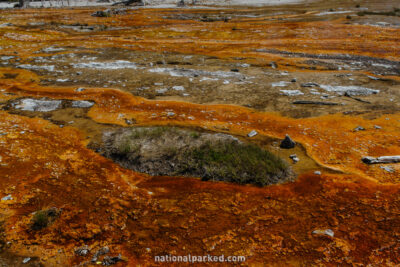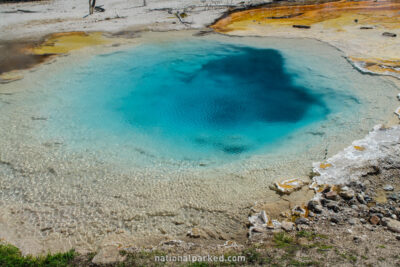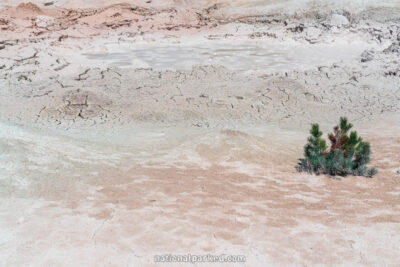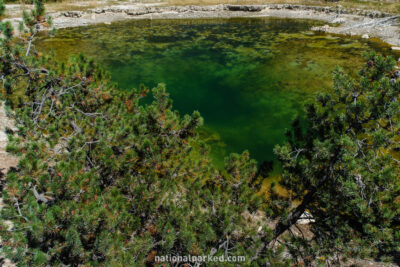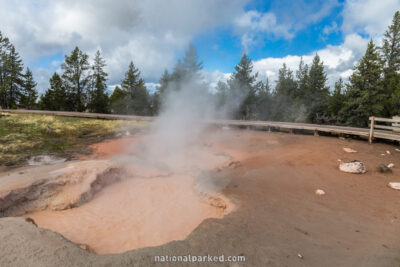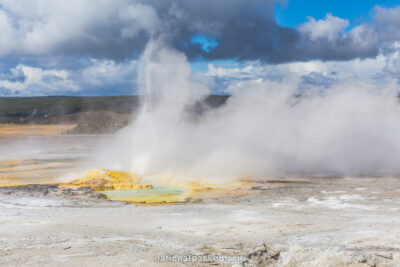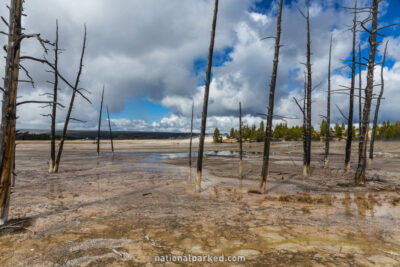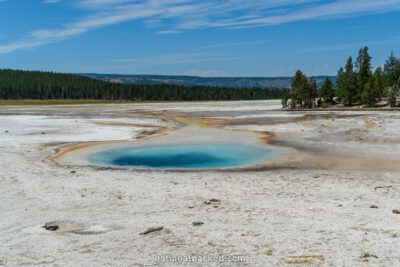Fountain Paint Pots Thermal Area
Fountain Paint Pots is a section of the Lower Geyser Basin accessed by boardwalk. To reach it, drive 7.8 miles north of the Old Faithful Interchange, or 8.3 miles south of Madison Junction on the Old Faithful to Madison section of the Grand Loop Road. The exit of the one-way Firehole Lake Drive is almost across the street from here. All four major types of thermal features are found here: geysers, pools, mudpots, and fumaroles.
Thermophile Mats
The boardwalk leaves the parking area and soon splits. The walk is a loop, so either direction is fine, but we will follow to the right, counterclockwise. Almost immediately is a large area of bacterial mats. These “thermophiles” can survive in very hot temperatures. The colors are a clue to the water’s temperature. At the hottest temperatures (as high as 167°F) they are yellow or green. As the temperature drops, they become orange, rust, and even brown colored.
Silex Spring
A short way down the boardwalk is Silex Spring. This spring’s water is very hot, evidenced by the clear blue color. Thermophiles cannot survive in water this hot, but they thrive in the runoff water around the spring, which is cooler. Silex is Latin for silica, which is a major component of rhyolite, Yellowstone’s most common volcanic rock.
Fountain Paint Pots
Just to the left of the Silex Spring area is the namesake of this area, the Fountain Paint Pots themselves. Boardwalks encircle the entire area, allowing for views from all angles. Rock in this area contains feldspar, which is broken down by the acids in the water into a clay. The hot water mixes with this clay to form the mudpots. They vary by season as well. Spring and early summer rain and snowmelt keep them thin, while by late summer they are quite thick, as shown to the left.
Leather Pool
To the right away from the Fountain Paint Pots is another hot spring. This one is named Leather Pool for the thick mats of brown thermophiles that resemble leather. Leather Pool temporarily lost its brown color after a 1959 earthquake raised the pool’s temperature to boiling and killed all of the bacteria.
Red Spouter
A short way down from Leather Pool is a feature called the Red Spouter, which was created by the 1959 earthquake. In the high water of spring, it is a splashing, muddy pool. Later, as water levels drop, it becomes a steam vent, known as a fumarole. This state is pictured to the left.
Clepsydra Geyser
On down the boardwalk toward the opposite end is a collection of geysers. Twig, Jet, Spasm, Morning, Fountain, and Clepsydra Geyser (shown at left) are all in this area. The last erupts nearly constantly, but the others are less common.
Lodgepole Pines
As the loop heads back toward the parking lot, a number of dead lodgepole pines can be seen. They were drowned by shifting hot springs and hardened by silica absorbed into their base.
Celestine Pool
Just before the loop terminates at the short walk back to the parking lot is Celestine Pool. This is a medium sized pool with a deep blue color.
